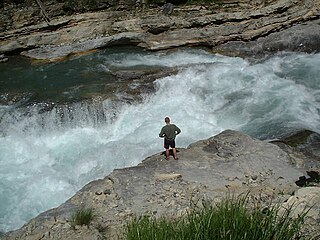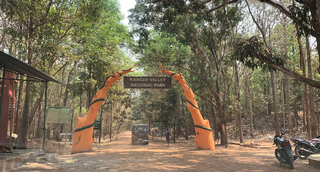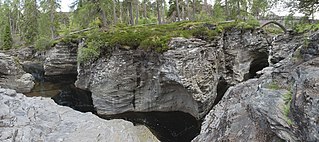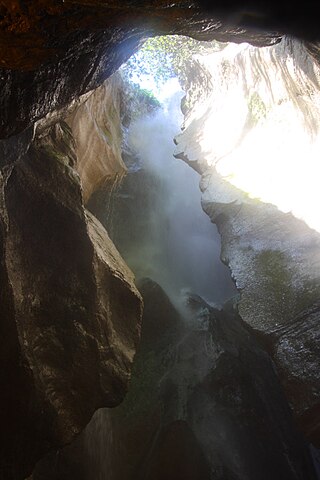Location and description
Caldron Linn is about a mile below Rumbling Bridge, and can be accessed through fields by Powmill, with a 150 ft slippery descent to reach it. The height of its fall was lessened in 1886 by rock fall.
The Scottish Tourist, an 1838 guidebook, says of the waterfall: [1]
Here are two cataracts, distant from each other 28 yards. The upper fall, thirty-four feet in height, declines a little from the perpendicular; the rocks rise out of the channel, and there is one like a pillar, horizontal at the top, by which many persons have passed from one side to the other. Between these falls, the river has formed three round cavities, having the appearance of large caldrons or boilers. In the first, the water is perpetually agitated as if it were boiling; in the second, it is covered with a constant foam ; in the third, which is the largest, being 22 feet in diameter, it appears as if spread out in a large cooler.
These cavities are separated from each other by ledges of rock; they communicate, not by the water running over their brim, but by apertures about middle depth in their ledges, wrought out in the course of ages by the action of the water. The lower caldron discharges the water into the last fall through a similar aperture, having the appearance of a door or large window hewn out of the rock. Through this opening, the river rushes in one vast and rapid torrent over a stupendous pile of perpendicular rocks, into a deep and romantic glen.
The noise of its fall is tremendous, and the rocks seem to tremble to their centre, while the mind of the spectator is deeply affected by emotions of wonder and admiration. The height of the rock is 88 feet, and the fall 44.
The most complete view of this magnificent scene, and of the deep and finely-wooded dell, is from the bottom of the great fall, where it has the appearance of a prodigious fountain gushing from the solid rock. It is beheld to most advantage between one and two o'clock in the afternoon, when the sun shines directly in front of it. A vapour constantly ascends from the pool; in sunshine this vapour exhibits all the colours of the rainbow, which, by the constant agitation of the air, disperse, and again appear in the most beautiful combinations.
The Caldron Linn, in short, is perhaps the greatest natural curiosity, and certainly one of the most sublime objects in Scotland. More than twenty years ago [c.1818] the following extraordinary occurrence happened at this place: a fox, which was hard pursued by a pack of hounds, led them along the banks of the river, till he reached the boiling caldron, which he crossed; the dogs attempted to follow, but being unacquainted with the path, they fell, one after another, into the caldron, and were drowned. Several years ago, a gentleman fell into the same caldron, and was extricated with the greatest difficulty.
The water flow of the Linn is now diminished by a recent hydro-electric scheme commissioned in 1993. [2]

High Force is a waterfall on the River Tees, near Middleton-in-Teesdale, Teesdale, England. The waterfall is within the North Pennines Area of Outstanding Natural Beauty (AONB) and the European Geopark. The whole of the River Tees plunges 70 feet (21 m) over a precipice in two stages. After heavy rainfall the river will also flow over the usually dry right-hand side channel, creating two falls. Very occasionally the river level will be high enough to flow over the central section of rock; the last recorded time this happened was in December 2015 after Storm Desmond. In harsh winters the falls have been known to freeze, creating cathedral-like ice formations.

A waterfall is any point in a river or stream where water flows over a vertical drop or a series of steep drops. Waterfalls also occur where meltwater drops over the edge of a tabular iceberg or ice shelf.

The American Falls is the second largest of the three waterfalls that together are known as Niagara Falls on the Niagara River along the Canada–United States border. Unlike the much larger Horseshoe Falls, of which approximately 90% is in Ontario, Canada, and 10% in the U.S. state of New York, the American Falls is entirely within the United States.

Whitewater forms in the context of rapids, in particular, when a river's gradient changes enough to generate so much turbulence that air is trapped within the water. This forms an unstable current that froths, making the water appear opaque and white.

The Boiling Lake is a flooded fumarole located in Morne Trois Pitons National Park, a World Heritage Site on the island of Dominica. The lake, located 6.5 miles (10.5 km) east of Dominica's capital Roseau, is filled with bubbling greyish-blue water that is usually enveloped in a cloud of vapour. The Boiling Lake is approximately 200 to 250 feet across and is the second-largest hot lake in the world after Frying Pan Lake, located in Waimangu Valley near Rotorua, New Zealand.

Kanger Valley National Park is a national park in the Bastar region of Chhattisgarh state in India. It came into existence in July 1982 and covers an area of approximately 200 square kilometres (77 sq mi). The park extends from the Teerathagarh waterfalls in the west to the Kolab river in the east, spanning an average length of 33.5 km (20.8 mi) and an average width of 6 km (3.7 mi) from north to south. It derives its name from the Kanger river, which flows centrally through it. Situated at a distance of 30 km (19 mi) southeast of Jagdalpur city, it is one of India's densest national parks and is known for its biodiversity, landscape, waterfalls, and subterranean geomorphologic limestone caves. It is also the home to the Bastar hill myna, the state bird of Chhattisgarh.

Jawhar is a city and a municipal council in Palghar district of Maharashtra state in Konkan division of India. Jawhar was a capital city of the erstwhile princely state of Jawhar. Situated in the ranges of the Western Ghats, Jawhar is known for its picturesque setting and a vibrant cultural heritage. It is one of the few remaining tribal regions of Maharashtra and is known for its vibrant Warli painting that are a characteristic landmark of this place. Established in 1918, Jawhar is one of the oldest municipal councils in the state of Maharashtra and tourist spot near Mumbai.

A plunge pool is a deep depression in a stream bed at the base of a waterfall or shut-in. It is created by the erosional forces of cascading water on the rocks at the formation's base where the water impacts. The term may refer to the water occupying the depression, or the depression itself.

Chunchanakatte Falls is a waterfall on the Kaveri River, near the village of Chunchanakatte in saligrama taluk of Mysore district, Karnataka, India. Water cascades from a height of about 20 meters. It is in the Western Ghats. Here the river falls in two small cascades before joining again to flow as one.

Archbald Pothole State Park is a 149.16-acre (60.36 ha) Pennsylvania state park in Archbald, Lackawanna County, Pennsylvania. The focal point of the park is Archbald Pothole. The pothole is a remnant of the Wisconsin Glacial Period, 38 feet (11.6 m) deep with a largest diameter of 42 feet (12.8 m) by 24 feet (7.3 m). It has drawn tourists since just after it was discovered in 1884. Archbald Pothole State Park is on U.S. Route 6 Business in the borough of Archbald.

The Falls of Bruar are a series of waterfalls on the Bruar Water in Scotland, about 8 miles from Pitlochry in the council area of Perth and Kinross. They have been a tourist attraction since the 18th century and were immortalized in a poem by Robert Burns, The Humble Petition of Bruar Water to the Noble Duke of Atholl, supposedly from the river itself entreating the Duke to plant some trees in the then barren landscape.

Linville Falls is a waterfall located in the Blue Ridge Mountains of North Carolina in the United States. The falls move in several distinct steps, beginning in a twin set of upper falls, moving down a small gorge, and culminating in a high-volume 45-foot (14 m) drop.

Tower Fall is a waterfall on Tower Creek in the northeastern region of Yellowstone National Park, in the U.S. state of Wyoming. Approximately 1,000 yards (910 m) upstream from the creek's confluence with the Yellowstone River, the fall plunges 132 feet (40 m). Its name comes from the rock pinnacles at the top of the fall. Tower Creek and Tower Fall are located approximately three miles south of Roosevelt Junction on the Tower-Canyon road.

In Scotland and northern England, a Linn is a geographical water feature, a watercourse that has cut through a shelf of hard rock creating a narrow (usually), steep-sided crevice (fracture) through which it runs.

Rumbling Bridge is a small village built on both sides of a gorge of the River Devon, which formed the boundary between the historic counties of Perthshire and Kinross-shire and is now within the combined Perth and Kinross council area, Scotland, where the A823 leaves the A977. It lies roughly one mile equidistant from Muckhart to its north, Crook of Devon to its east and Powmill to its south. Comprising only a few scattered houses until the mid-20th century, most property in the village dates from the 1970s onwards.
The Bonnington Pavilion or Hall of Mirrors, now a ruin, is situated in the grounds of the old estate of Bonnington, near New Lanark, overlooking Corra Linn falls on the River Clyde in Lanarkshire, Scotland. Alternative names are the Corra Linn Pavilion and the Falls of Clyde summerhouse. It is said to have been the first Camera obscura built in Scotland. The name comes from the Gaelic 'currach', a marshy place. A legend gives 'Cora' as a daughter of King Malcolm II, who leapt to her death here whilst trying to escape imagined danger.

Havasu Creek is a stream in the U.S. state of Arizona. It is a tributary to the Colorado River, which it joins in the Grand Canyon. It primarily runs through the Havasupai Indian Reservation. It is sometimes called Cataract Creek, and should not be confused with Cataract Canyon, Utah.

The Cascate del Varone are pair of waterfalls that fall into a vertical cave located 3 kilometers north-west of the northern end of Lake Garda and the city of Riva del Garda in northern Italy. The name Varone has its origin from the town of Varone a short distance away.

Osprey Falls is a waterfall on the Gardner River in northwestern Yellowstone National Park in the United States. Osprey Falls has a drop of approximately 150 feet (46 m). The falls are located within Sheepeater Canyon and are reachable via the Osprey Falls trail.




















